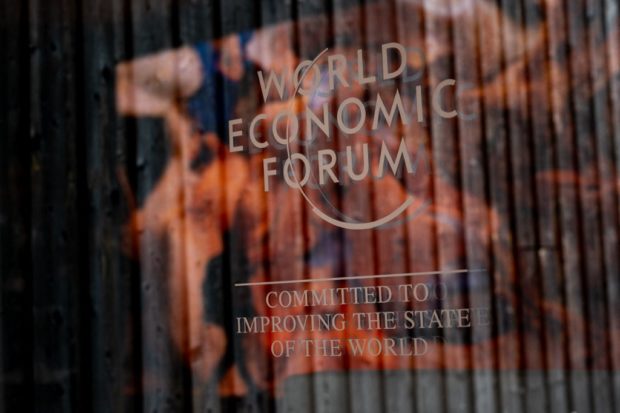Experts warn anew vs reclamation, other climate impacts

A photograph shows a sign of the World Economic Forum (WEF) at the Congress center on the opening day of the World Economic Forum (WEF) annual meeting in Davos on January 16, 2023. – The world’s political and business elites gather for the annual Davos summit to promote “cooperation in a fragmented world”, with the war in Ukraine, the climate crisis, and global trade tensions high on the agenda. (Photo by FABRICE COFFRINI / Agence France-Presse)
MANILA, Philippines — With the recently concluded World Economic Forum (WEF) in Davos, Switzerland, Southeast Asian countries are racing against time to adapt to the climate crisis, as scientists point to unplanned development projects in megacities’ rapidly urbanizing coastlines.
Joo-Ok Lee, head of the Asia-Pacific agenda of the WEF executive committee, noted that Asean member states “are suffering other climate-related changes, typically in the form of unseasonably heavy rains causing flooding, and this situation can only deteriorate.”
“For Indonesia and the Philippines, with their large archipelagos and many island dwellers, the prospect of rising sea levels is devastating,” wrote Lee in a WEF article on Jan. 16.
Just last year, the Intergovernmental Panel on Climate Change (IPCC) report warned that the region “will witness increased losses in coastal settlements and infrastructure due to flooding caused by unavoidable sea-level rise.”
Significant barriers to climate adaptation in Asia include fragmented, reactive governance, inadequate evidence on which actions to prioritize and how to sequence them, and lack of finances, said the IPCC.
Article continues after this advertisementMassive reclamation
In the Philippines and Thailand, scientists warned that massive reclamation could worsen the impacts of extreme sea level rise (ESLR) in vulnerable communities.
Article continues after this advertisementMetro Manila is in a low-lying area facing the sea and is embracing two river systems, making it prone to flooding and disasters.
Some of the coastal areas of Manila are extremely low-lying, particularly Camanava, a populous subregion of component cities Caloocan, Malabon, Navotas, and Valenzuela.
Massive reclamation projects cannot only uproot mangrove forests and destroy the marine ecosystem, it can also worsen the rising sea levels in Bulacan and Metro Manila, scientists believe.
In a report published last year, Greenpeace East Asia outlined the projected economic impact of ESLR in seven Asian cities by 2030.
The projection for Manila is damning: Almost 87 percent of the megacity’s land area is below the level to which sea water could rise should a 10-year floor occur in 2030, impacting $39.24 billion of the country’s gross domestic product and putting 1.54 million people at risk.
Manila is not alone in this plight.
In Jakarta, almost 17 percent of communities are below the level to which sea water could rise should a 10-year flood occur in 2030, according to Greenpeace.
‘Slow onset disaster’
Bangkok, meanwhile, stands to lose around $12 billion of its GDP and 10.45 million lives due to ESLR by 2030, as the “city’s vulnerability to flooding is exacerbated by the fact that the city is sinking due to soft soils, heavy urbanization and land subsidence,” according to Greenpeace.
When the sea rises, it results in more in-land coastal flooding and tidal flooding that exposes communities, especially Camanava in Metro Manila, to more hazards, noted geologist Narod Eco, a former researcher for the University of the Philippines’ National Institute of Geological Sciences and a member of Agham.
For scientists, sea level rise and land subsidence due to the overextraction of groundwater can form a dangerous combo for at-risk communities.
“Sea level rise’s order of magnitude is in millimeters per year. It’s a slow onset disaster that is difficult to see in real-time, same with strong typhoons that are low frequency but high impact events,” said Eco.
But he said land subsidence is “more pronounced” and “more urgent,” as it is measured in centimeters per year.
“Previous study that we did showed that coastal communities in Camanava and Bulacan are the most severely affected by land subsidence. Coupled with reclamation in these areas, you’re putting up development directly on those areas where it is dangerous to do so, with all those hazards and possible disasters,” he added.